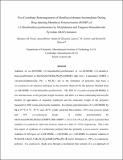| dc.contributor.author | Flook, Margaret M. | |
| dc.contributor.author | Kilyanek, Stefan M. | |
| dc.contributor.author | Gerber, Laura C. H. | |
| dc.contributor.author | Borner, Janna | |
| dc.contributor.author | Schrock, Richard Royce | |
| dc.date.accessioned | 2014-01-21T17:25:57Z | |
| dc.date.available | 2014-01-21T17:25:57Z | |
| dc.date.issued | 2012-08 | |
| dc.date.submitted | 2012-06 | |
| dc.identifier.issn | 0276-7333 | |
| dc.identifier.issn | 1520-6041 | |
| dc.identifier.uri | http://hdl.handle.net/1721.1/84101 | |
| dc.description.abstract | Addition of rac-DCENBE (2,3-dicarboethoxynorbornene) or rac-DCBNBE (2,3-dicarbo-tert-butoxynorbornene) to Mo(NAd)(CHCMe[subscript 2]Ph)(Pyr)(OHMT) (1a) (Ad = 1-adamantyl, OHMT = 2,6-dimesitylphenoxide, Pyr– = NC[subscript 4]H[subscript 4]–) led to the formation of polymers that have a cis,syndiotactic,alt structure analogous to the structure observed for the polymer obtained from rac-DCMNBE (2,3-dicarbomethoxynorbornene). The PDI of cis,syndio,alt-poly(DCBNBE) is low and decreases as the polymer length increases, and there is a linear relationship between the number of equivalents of monomer employed and the molecular weight of the polymers measured in THF versus polystyrene standards. In contrast, polymerization of (+)-DCMNBE by 1a at 25, 0, −25, and −40 °C yields a polymer that contains ~25% trans,isotactic dyads and 75% cis,syndiotactic dyads. A similar polymerization by Mo(NAd)(CHCMe[subscript 2]Ph)(Pyr)(OHIPT) (1b) (OHIPT = 2,6-(2,4,6-i-Pr[subscript 3])[subscript 2]C[subscript 6]H[subscript 3]) gives a polymer that contains cis,syndiotactic and trans,isotactic dyads in a ratio of ~8:92, respectively. This is the first report of synthesis of a norbornene polymer that has primarily a trans,isotactic structure. Addition of 100 equiv of (+)-DCMNBE, (−)-DCENBE, or (−)-DCBNBE to a toluene solution of W(O)(CH-t-Bu)(2,5-Me[subscript 2]NC[subscript 4]H[subscript 2])(OHMT)(PMe[subscript 2]Ph) (5) led to formation of ~99% cis,syndiotactic polymer. Cis,syndiotactic dyads arise through a mechanism that consists of a syn approach of the monomer to a syn alkylidene isomer followed by inversion of configuration at the metal center as a consequence of an exchange of aryloxide and pyrrolide ligands. The mechanism for formation of trans,isotactic dyads is one in which the monomer approaches in an anti fashion to the syn isomer followed by a “turnstile” rotation in the five-coordinate intermediate metallacyclobutane that allows the metallacylic ring to open productively with retention of configuration at the metal center. The metallacyclobutane intermediate that gives rise to trans,isotactic dyads in the copolymer could be regarded as a relatively high energy species with a “nonideal” structure compared to a trigonal bipyramidal or a square pyramidal structure. | en_US |
| dc.description.sponsorship | United States. Dept. of Energy (DE-FG02-86ER13564) | en_US |
| dc.language.iso | en_US | |
| dc.publisher | American Chemical Society (ACS) | en_US |
| dc.relation.isversionof | http://dx.doi.org/10.1021/om300530p | en_US |
| dc.rights | Article is made available in accordance with the publisher's policy and may be subject to US copyright law. Please refer to the publisher's site for terms of use. | en_US |
| dc.source | Prof. Schrock via Erja Kajosalo | en_US |
| dc.title | Five-Coordinate Rearrangements of Metallacyclobutane Intermediates During Ring-Opening Metathesis Polymerization (ROMP) of 2,3-Dicarboalkoxynorbornenes by Molybdenum and Tungsten Monoalkoxide Pyrrolide (MAP) Initiators | en_US |
| dc.title.alternative | Five-Coordinate Rearrangements of Metallacyclobutane Intermediates during Ring-Opening Metathesis Polymerization of 2,3-Dicarboalkoxynorbornenes by Molybdenum and Tungsten Monoalkoxide Pyrrolide Initiators | en_US |
| dc.type | Article | en_US |
| dc.identifier.citation | Flook, Margaret M., Janna Borner, Stefan M. Kilyanek, Laura C. H. Gerber, and Richard R. Schrock. “Five-Coordinate Rearrangements of Metallacyclobutane Intermediates during Ring-Opening Metathesis Polymerization of 2,3-Dicarboalkoxynorbornenes by Molybdenum and Tungsten Monoalkoxide Pyrrolide Initiators.” Organometallics 31, no. 17 (September 10, 2012): 6231-6243. | en_US |
| dc.contributor.department | Massachusetts Institute of Technology. Department of Chemistry | en_US |
| dc.contributor.approver | Schrock, Richard Royce | en_US |
| dc.contributor.mitauthor | Flook, Margaret M. | en_US |
| dc.contributor.mitauthor | Kilyanek, Stefan M. | en_US |
| dc.contributor.mitauthor | Gerber, Laura C. H. | en_US |
| dc.contributor.mitauthor | Borner, Janna | en_US |
| dc.contributor.mitauthor | Schrock, Richard Royce | en_US |
| dc.relation.journal | Organometallics | en_US |
| dc.eprint.version | Author's final manuscript | en_US |
| dc.type.uri | http://purl.org/eprint/type/JournalArticle | en_US |
| eprint.status | http://purl.org/eprint/status/PeerReviewed | en_US |
| dspace.orderedauthors | Flook, Margaret M.; Borner, Janna; Kilyanek, Stefan M.; Gerber, Laura C. H.; Schrock, Richard R. | en_US |
| dc.identifier.orcid | https://orcid.org/0000-0001-5827-3552 | |
| dspace.mitauthor.error | true | |
| mit.license | PUBLISHER_POLICY | en_US |
| mit.metadata.status | Complete | |
